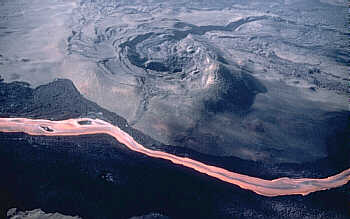Fake Astronauts Undertake Four-Month Fake Mission To Mars
It might be awhile before we actually put a human on Mars, but Hawaii Space Exploration Analog and Simulation (HI-SEAS) is exploring the challenges with a four-month-long simulated Mars Mission.
Each week, astronaut Kate Greene blogs about different aspects of the simulated mission, giving viewers a glimpse into the life of an astronaut and what a trip to Mars might actually entail, especially when it comes to feeding astronauts. The simulation is taking place on the Big Island of Hawaii, where Greene and five other crewmates live inside of the Mauna Loa volcano.

They’re living in a two-story dome of roughly 1,000 square feet in which they eat, sleep, work, play, and exercise. If they go outside of the dome, they have to don mock spacesuits (I guess those are kind of like mock turtlenecks).
The simulation, funded by NASA (you don’t hear that often enough), focuses in particular on astronaut food for “long-haul” space missions. They’re trying to determine whether the weird dehydrated meals most of us generally associate with space would be sufficient for longer missions, and what possible alternatives might be. While it might seem kind of neat to construct a meal from dehydrated bits or by squeezing it from a tube (they don’t do that anymore, in case you were wondering), space food is, understandably, pretty gross. In fact, NASA admits that “the food that NASA’s early astronauts had to eat in space is a testament to their fortitude” in this chronicle of space food.
Space food has gotten better, though. Astronauts now use actual utensils, as well as hot water, to rehydrate meals. One aspect examined by the HI-SEAS simulation is whether it might make sense for astronauts to cook some meals if they’re going as far as Mars — after all, how many rehydrated meals out of pouches can one crew eat? One of the bigger concerns on longer missions is that the astronauts will lose too much weight, which affects performance. Trips to Mars would take over a year, likely a few years, so a long-term plan for eating and sustaining health is critical.
It’s helpful that Mars has gravity. Even at roughly a third of Earth’s, Mars’ gravity would make it possible to cook and bake, which would be a cosmic culinary revelation. On the HI-SEAS simulated mission, the crew eats the usual add-water meals, and they’ll also try cooking some meals with “shelf-stable” ingredients like dehydrated vegetables, grains, and Spam. Well, two out of three ain’t bad. Throughout the 120-day simulation, the astronauts will carefully monitor weight, activity level, calorie consumption, and other metrics to assemble data for the planning of long-term missions.
In addition to what and how they eat, the HI-SEAS crew attempts to simulate all aspects of life on Mars. They’ll be testing rovers and textiles, mapping their habitat, and, of course, blogging and maintaining websites. I imagine they’ll also make a few sacrifices to the Mauna Loa volcano so it plays nice while they’re there.
Space exploration has come a long way since the time of John Glenn, but I was strangely happy to learn that astronauts still drink Tang — in fact, it’s available on board the International Space Station. I guess some things will never change.












